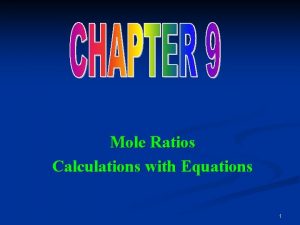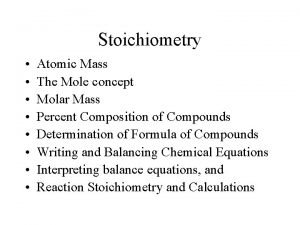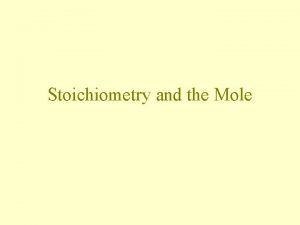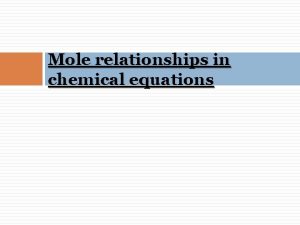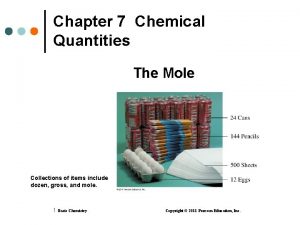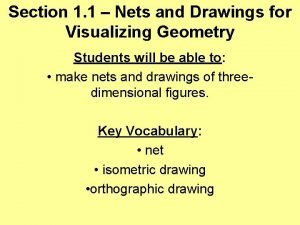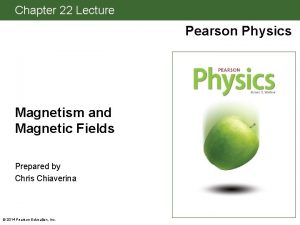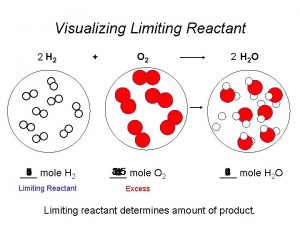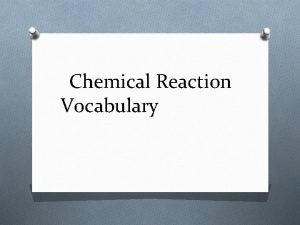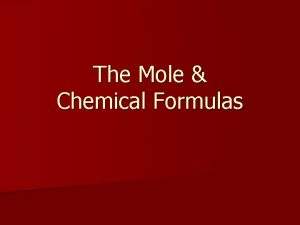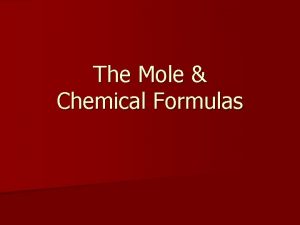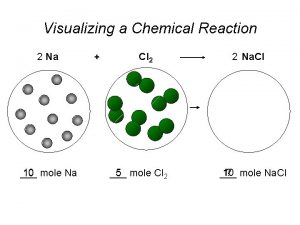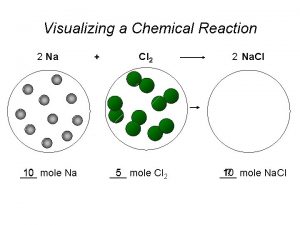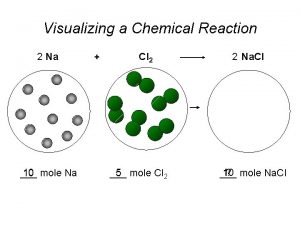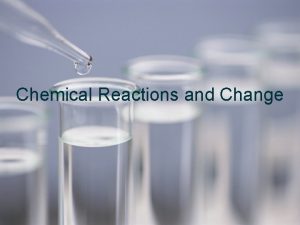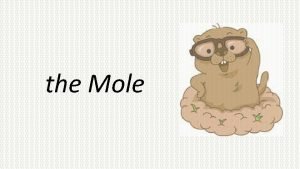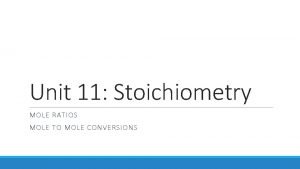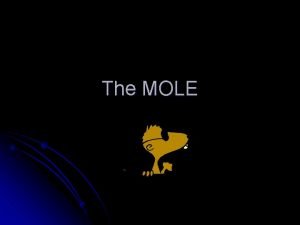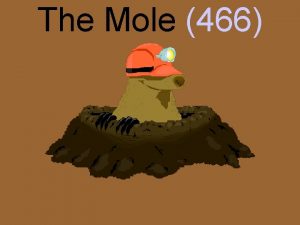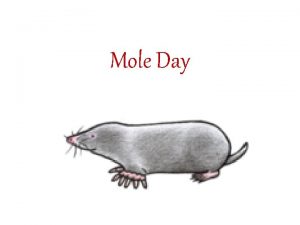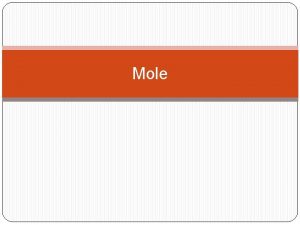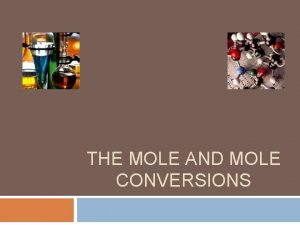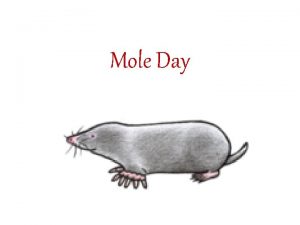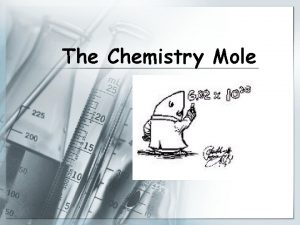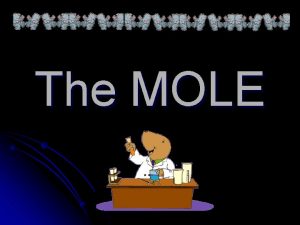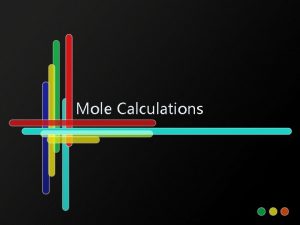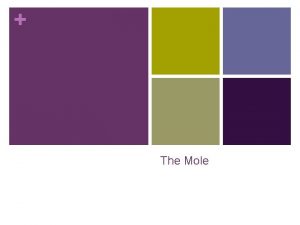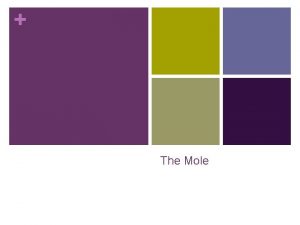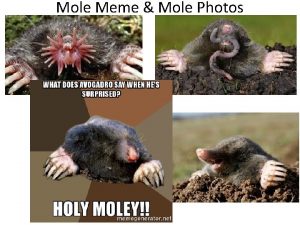Visualizing a Chemical Reaction 2 Na 10 mole
























- Slides: 24

Visualizing a Chemical Reaction 2 Na 10 mole Na ___ + Cl 2 5 mole Cl 2 ___ 2 Na. Cl 10 ? mole Na. Cl ___

Formation of Ammonia

Proportional Relationships 2 1/4 c. flour 1 tsp. baking soda 1 tsp. salt Conversion Factor 1 c. butter 3/4 c. sugar 3/4 c. brown sugar 1 tsp vanilla extract 2 eggs 2 c. chocolate chips Makes 5 dozen cookies. I have 5 eggs. How many cookies can I make? 5 eggs 5 dozen 2 eggs Ratio of eggs to cookies 150 dozen cookies = 12. 5 Courtesy Christy Johannesson www. nisd. net/communicationsarts/pages/chem

Proportional Relationships • Stoichiometry – mass relationships between substances in a chemical reaction – based on the mole ratio • Mole Ratio – indicated by coefficients in a balanced equation 2 Mg + O 2 2 Mg. O Courtesy Christy Johannesson www. nisd. net/communicationsarts/pages/chem

Stoichiometry Steps 1. Write a balanced equation. 2. Identify known & unknown. 3. Line up conversion factors. – – – Mole ratio moles Molarratio mass grams Mole - - moles Molarity moles liters soln Molar volume moles liters gas Core step in all stoichiometry problems!! 4. Check answer. Courtesy Christy Johannesson www. nisd. net/communicationsarts/pages/chem

Molar Volume at STP 1 mol of a gas=22. 4 L at STP Standard Temperature & 0°C and 1 atm Courtesy Christy Johannesson www. nisd. net/communicationsarts/pages/chem Pressure

Molar Volume at STP LITERS OF GAS AT STP Molar Volume (22. 4 L/mol) MASS IN GRAMS Molar Mass (g/mol) 6. 02 1023 MOLES particles/mol NUMBER OF PARTICLES Molarity (mol/L) LITERS OF SOLUTION Courtesy Christy Johannesson www. nisd. net/communicationsarts/pages/chem

Stoichiometry Problems • How many moles of KCl. O 3 must decompose in order to produce 9 moles of oxygen gas? 2 KCl. O 3 2 KCl + 3 O 2 ? mol 9 mol O 2 2 mol KCl. O 3 3 mol O 2 9 mol = 6 mol KCl. O 3 Courtesy Christy Johannesson www. nisd. net/communicationsarts/pages/chem

1. 2 Sb + 3 Cl 2 2 Sb. Cl 3 2. 2 Mg + O 2 2 Mg. O 3. Ca. Cl 2 Ca + Cl 2 4. 2 Na. Cl. O 3 2 Na. Cl + 3 O 2 5. Fe + 2 HCl Fe. Cl 2 + H 2 6. Cu. O + H 2 Cu + H 2 O 7. 2 Al + 3 H 2 SO 4 Al 2(SO 4)3 + 3 H 2

2 1. 5 mol 2 Sb + 3 Cl 2 2 Sb. Cl 3 excess 5 mol 7. 5 excess x mol = 3 x mol 2 x = 15 x = 7. 5 mol x mol How many moles of chlorine gas are required to react with 5 moles of antimony? x mol Cl 2 = 5 mol Sb 3 mol Cl 2 2 mol Sb = 7. 5 mol Cl 2 How many moles of Sb. Cl 3 are produced from 5 moles of antimony and excess Cl 2? x mol Sb. Cl 3 = 5 mol Sb 2 mol Sb. Cl 3 2 mol Sb = 5 mol Sb. Cl 3 How many moles of Sb. Cl 3 are produced from 7. 5 moles of Cl 2 and excess Sb? x mol Sb. Cl 3 = 7. 5 mol Cl 2 2 mol Sb. Cl 3 3 mol Cl 2 = 5 mol Sb. Cl 3

2. 2 Mg + O 2 2 Mg. O 10 mol x. L x mol How many moles of magnesium oxide are produced from the burning of 10 mol of Mg? x mol Mg. O = 10 mol Mg 2 mol Mg. O 2 mol Mg = 10 mol Mg. O How many liters of oxygen are needed to burn 10 mol of Mg? Assume 1 mol O 2 = 22. 4 L x L O 2 = 10 mol Mg 1 mol O 2 2 mol Mg = 5 mol O 2 1 mol O 2 22. 4 L O 2 2 mol Mg 1 mol O 2 22. 4 L O 2 1 mol O 2 = 112 L O 2

3. Ca. Cl 2 Ca + Cl 2 8 mol x mol How many moles of calcium metal and chlorine gas are produced from the decomposition of 8 mol of calcium chloride? x mol Ca = 8 mol Ca. Cl 2 1 mol Ca. Cl 2 = 8 mol Ca How many moles of calcium metal and chlorine gas are produced from the decomposition of 8 mol of calcium chloride? x mol Cl 2 = 8 mol Ca. Cl 2 1 mol Ca. Cl 2 = 8 mol Cl 2

Ions in Aqueous Solution Pb(NO 3)2(s) + H 2 O(l) Print Copy of Lab Pb(NO 3)2(aq) Pb 2+(aq) + 2 NO 31–(aq) Pb 2+ NO 31– dissociation: Na. I(s) + H 2 O(l) Na 1+ I 1– add water Pb 2+ NO 31– Na. I(aq) Na 1+(aq) + I 1–(aq) Na 1+ I 1– Mix them and get… Balance to get overall ionic equation… Cancel spectator ions to get net ionic equation… in solution

Solubility Chart Mix them and get… Pb(NO 3)2(aq) + 2 Na. I(aq) Pb 2+ Na 1+ Pb. I 2(s) ++ 2 Na. NO (aq) + 2 Na 1+(aq) NO 31– 3 (aq) I 1– NO 31– Pb 2+ NO 31– I 1– Na 1+ solid I 1– NO 31– in solution Na 1+ I 1– Na 1+ NO 31– Balance to get overall ionic equation… Pb 2+(aq) + 2 NO 31–(aq) + 2 Na 1+(aq) + 2 I 1–(aq) Pb. I 2(s) + 2 NO 31–(aq) + 2 Na 1+(aq) Cancel spectator ions to get net ionic equation… Pb 2+(aq) + 2 I 1–(aq) Pb. I 2(s)

Solubility Chart Mix together Zn(NO 3)2(aq) and Ba(OH)2(aq): Mix them and get… Ba(NO 3)2(aq) and Zn(NO 3)2(aq) + Ba(OH)2(aq) Zn(OH)2 (ppt) Zn(OH)2(s) + 2 NO 31–(aq) + Ba 2+(aq) Zn(NO 3)2(aq) Ba(OH)2(aq) Zn 2+(aq) + 2 NO 31–(aq) Ba 2+(aq) + 2 OH 1–(aq) OH 1– NO 31– Ba 2+ Zn 2+ NO 31– OH 1– Balance to get overall ionic equation… Zn 2+(aq) + 2 NO 31–(aq) + Ba 2+(aq) + 2 OH 1–(aq) Zn(OH)2(s) + 2 NO 31–(aq) + Ba 2+(aq) Cancel spectator ions to get net ionic equation… Zn 2+(aq) + 2 OH 1–(aq) Zn(OH)2(s)

6 NH? 4 OH 2 (NH 4)3 PO 4 + 3 Mg(OH)2 Mg 3(PO 4)2 + ammonium phosphate magnesium hydroxide magnesium phosphate ammonium hydroxide NH 41+ OH 1 - Now you try… 2 Al. Cl 3 + 3 Li 2 CO 3 Al 2(CO 3)3 + 6 Li. Cl

Identify the spectator ions and write a net ionic equation when an aqueous solution of aluminum sulfate is mixed with aqueous ammonium hydroxide. Al 3+ SO 42 - aluminum sulfate + NH 41+ OH 1 - Al 3+ OH 1 - ammoniumhydroxide aluminum hydroxide + NH 41+ SO 42 - ammonium sulfate Al 2(SO 4)3(aq) + 6 NH 4 OH(aq) 2 Al(OH)3(ppt) + 3 (NH 4)2 SO 4 (aq) 2 Al 3+(aq) + 3 SO 42 -(aq) + 6 NH 41+(aq) + 6 OH 1 -(aq) 2 Al(OH)3(ppt) + 6 NH 41+(aq) + 3 SO 42 -(aq) “spectator ions” 2 Al 3+(aq) + 6 OH 1 -(aq) 2 Al(OH)3(ppt) Net Ionic Equation

Meaning of Coefficients 2 atoms Na 1 molecule Cl 2 2 molecules Na. Cl 2 Na + Cl 2 2 g sodium + 1 g chlorine 2 mol sodium (2 mol Na) x (23 g/mol) 2 Na. Cl = 1 mol chlorine (1 mol Cl 2) x (71 g/mol) 46 g 71 g 117 g 2 g sodium chloride 2 mol sodium chloride (2 mol Na. Cl) x (58. 5 g/mol) 117 g

Classes of Reactions Chemical reactions Precipitation reactions Oxidation-Reduction Reactions Combustion Reactions Acid-Base Reactions

Summary of Classes of Reactions Chemical reactions Precipitation reactions Oxidation-Reduction Reactions Combustion Reactions Synthesis reactions (Reactants are elements. ) Acid-Base Reactions Decomposition reactions (Products are elements. )

Summary of Classes of Reactions Chemical reactions Precipitation reactions Oxidation-Reduction Reactions Combustion Reactions Synthesis reactions Acid-Base Reactions Decomposition reactions

IONIC BONDING: Formation of Magnesium Chloride Cl Mg 2+ Cl Loses 2 e- Each gains 1 e- Cl One magnesium ion Mg 2+ [(2+) Mg. Cl 2 Two chloride ions Cl 12 (1 -) = 0] magnesium chloride

IONIC BONDING: Formation of Magnesium Chloride Cl Mg Mg 2+ Cl Loses 2 e- Each gains 1 e- Cl One magnesium ion Mg 2+ [(2+) Mg. Cl 2 Two chloride ions Cl 12 (1 -) = 0] magnesium chloride

Resources - Chemical Equations and Reactions Worksheet - vocabulary Worksheet – Balancing Chemical Equations Worksheet – Chemical Word Equations Worksheet – Quantitative Relationships in Chem. Eqns. Worksheet – Chemical Equations (paragraph) Worksheet – Real Life Chemistry Worksheet – Balancing Equations (visual) Worksheet Lab – Ions in Solution Textbook - questions Outline (general)
 Bomb power
Bomb power Mole-mole factor
Mole-mole factor Mol to mol conversion
Mol to mol conversion Stoichiometry worksheet #2 (mole-mass mass-mole problems)
Stoichiometry worksheet #2 (mole-mass mass-mole problems) Mole mass and mole volume relationships
Mole mass and mole volume relationships Atomic mass
Atomic mass Grams to gram
Grams to gram Stoichiometry mole-mole
Stoichiometry mole-mole Mole relationships in chemical equations
Mole relationships in chemical equations Unit chemical quantities the mole 1 step
Unit chemical quantities the mole 1 step Reaction rate formula
Reaction rate formula Addition reaction and substitution reaction
Addition reaction and substitution reaction Leukoerythroblastic reaction vs leukemoid reaction
Leukoerythroblastic reaction vs leukemoid reaction Nets and drawings for visualizing geometry
Nets and drawings for visualizing geometry Visualizing concepts
Visualizing concepts Visualizing reading strategy
Visualizing reading strategy Visualizing magnetic field
Visualizing magnetic field 1-1 nets and drawings for visualizing geometry answers
1-1 nets and drawings for visualizing geometry answers Visualizing and understanding convolutional neural networks
Visualizing and understanding convolutional neural networks Visualize and verbalize
Visualize and verbalize Organizing and visualizing variables
Organizing and visualizing variables Visualizing environmental science (doc or html) file
Visualizing environmental science (doc or html) file Visualizing and verbalizing activities
Visualizing and verbalizing activities Visualizing japanese grammar
Visualizing japanese grammar H
H

